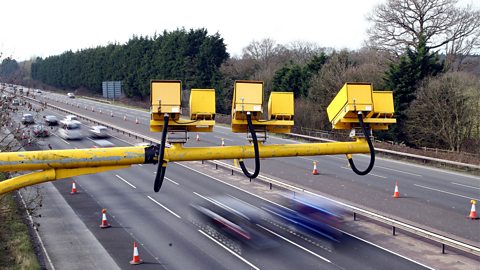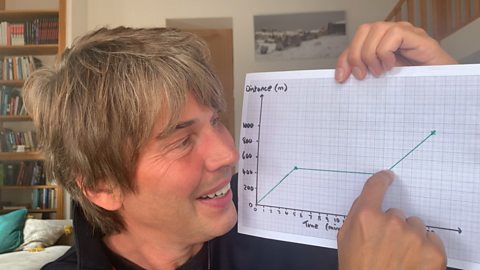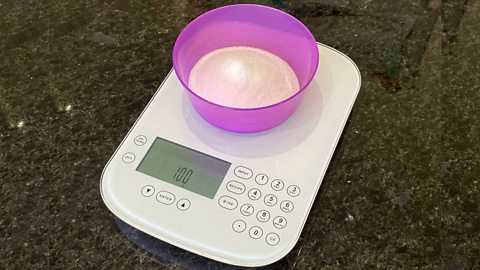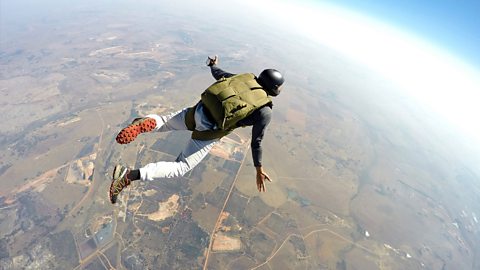Key points
Speed is a measure of how fast an object is moving.
Calculate speed using the speed equation - speed = distance divided by time.
The speed equation can be rearranged to find distance travelled and time taken.
What is speed?
speedA measure of how fast an object is moving.is a measure of how fast an object is moving.
To work out an object’s speed you need to know the distanceNumerical description of how far apart two things are. Measured in metres. it has travelled and the timeHow long an event lasts, measured in seconds. time taken.
Calculate speed using the equation \(speed = \frac {distance}{time} \).
The speed equation
Watch this vídeo of Professor Brian Cox explaining the speed equation.
Let's think now about the concept of motion and in particular, the idea of speed. What is speed?
Well, let's think about an example. Let's say that you're going to go from home to school, and school is one kilometre away from your house, that's a thousand metres.
And you've left yourself ten minutes to make that journey. What speed do you have to walk or run to get to school on time?
Well, speed is distance divided by time. In this case, that means one thousand metres, distance from home to school, divided by ten minutes, the time you've allowed yourself.
You have to travel one thousand metres in ten minutes. Your speed is the distance divided by the time, one thousand divided by ten equals one hundred metres per minute, which is quite a fast walk or even a bit of a jog.
Now, that makes sense, if you think about it, this definition of speed. What does it mean to travel at one hundred metres per minute?
It means literally that in one minute, you've travelled one hundred metres.
So in two minutes, you've travelled two hundred metres.
In three minutes, you've travelled three hundred metres.
In four minutes, you've travelled four hundred metres.
All the way to ten minutes, you've travelled a thousand metres, the distance from home to school.
In the video, what units are used to measure speed?
In the vídeo, speed was measured in metres per minute (m/min).
The most commonly used unit in Physics is metres per second (m/s).
Based on what you have learned about the speed equation in the video, have a go at this question.
Calculate the speed of a runner who runs 100m in 10s.
Speed = ?
Distance = 100m
Time = 10s
\( speed = \frac {distance}{time}\)
\( speed = \frac {100}{10}\)
\( speed = 10m/s\)
Rearranging the speed equation
The speed equation can be rearranged to find either the distance travelled or the time taken.

The speed equation is:
\(speed = \frac {distance}{time} \)
To find the distance the object has travelled, rearrange the speed equation to:
\(Distance = speed \times time\).
To find the time taken rearrange the speed equation to:
\( Time = \frac {distance}{speed} \).
Have a look at this example:
Calculate the distance travelled by a car in 10 s, travelling at a speed of 20 m/s
Speed = 20m/s
Distance = ?
Time = 10s
Step 1 - use the speed equation:
\( speed = \frac {distance}{time} \)
Step 2 - substitute in the values you know:
\(20 = \frac {distance}{10}\)
Step 3 - simplify the equation by multiplying both sides by 10 to remove the 10 from the bottom of the fraction on the right hand side:
\( 20 \times 10 = \frac {distance \times 10}{10}\)
This cancels to give:
\( 200m = distance \)
So the distance travelled is 200 metres
Now have a go at this question.
Calculate the time it takes a runner to cover 200 m at a speed of 8 m/s.
Speed = 8 m/s
Distance = 200m
Time = ?
Start with the speed equation:
\( speed = \frac{distance}{time} \)
Substitute in the values you know:
\(8 = \frac{200}{time}\)
To simplify this equation, multiply both sides by time. This will remove 'time’ from the bottom of the fraction:
\( 8 \times time = \frac{200 \times time}{time} \)
‘Time’ now cancels from the right hand side, because it appears on the top and bottom of the fraction:
\( 8 \times time = 200 \)
Simplify this equation by dividing both sides by 8, which will leave time on its own on the left:
\( \frac{8 \times time}{8} = \frac{200}{8} \)
\( time = \frac{200}{8}\)
\( time = 25s\)
So the time taken is 25 seconds.
Measuring speed
In science, speedA measure of how fast an object is moving. is typically measured in metres per second, m/s. This is the simplest unitA quantity that something is measured in. For example, the unit of distance is metres. of speed.
distanceNumerical description of how far apart two things are. Measured in metres. is measured in metres.
Sometimes a question will give distance measured in kilometres. You can convert kilometres into metres by multiplying it by 1000.
For example 10 km = 10 x 1000 = 10,000m.
timeHow long an event lasts, measured in seconds. is measured in seconds.
Speed cameras

Speed cameras are used to find out if a motorist is travelling faster than the speed limit for the road.
The camera takes two photos of the vehicle. The two photos can be taken:
- at a certain time apart so the distance travelled in that time can be measured
or
- a certain distance apart so the time taken can be measured.
The computer connected to the speed camera can then divide the value of ‘distance travelled’ by the value of ‘time taken’ to calculate the speed of the car.

Relative motion
If you have travelled in a car on the motorway, you may have noticed that other cars passing by appear to move slowly past you, even though you know the actual speeds of the two cars are very high. This is because of their relative motion to each other.
The calculation for relative speed depends on whether the objects are moving in the same direction or the objects are moving in opposite directions towards, or away from, each other.
Objects moving in the same direction
\(Relative~speed = fastest~speed - slowest~speed\)
For example:
Two cars are travelling in the same direction on a road.
The blue car is travelling at 25 m/s in front of the red car, which is travelling at 30 m/s. What is their relative speed?
\(Relative~speed = fastest~speed - slowest~speed\)
\(Relative~speed = 30 - 25\)
\(Relative~speed = 5 m/s\)
To a passenger in the red car, the blue car appears to be travelling past at 5 m/s.
Objects moving in opposite directions towards, or away from, each other
\(Relative~speed = speed~of~object~1 + speed~of~object~2\)
For example:
Two cars are travelling towards each other on a road.
The blue car is travelling at 15 m/s. The red can is travelling at 20m/s. What is their relative speed?
\(Relative~speed = speed~of~object~1 + speed~of~object~2\)
\(Relative~speed = 15 + 20\)
\(Relative~speed = 35 m/s\)
To a passenger in either car, it would appear that the other car is approaching at a speed of 35 m/s.
Motion Quiz
Teaching resources
Are you looking for more content on motion and speed to share with your students? This series of short explainer films with Professor Brian Cox focuses on forces, speed and motion. Each clip uses simple terms and concrete examples to explain deep concepts that students often struggle to grasp.
≥…»ÀøÏ ÷ Teach has thousands of free, curriculum-linked resources to help deliver lessons - all arranged by subject and age group.
Play the Atomic Labs game! gamePlay the Atomic Labs game!
Try out practical experiments in this KS3 science game.

More on Forces and movement
Find out more by working through a topic
- count5 of 16

- count6 of 16

- count7 of 16

- count8 of 16
